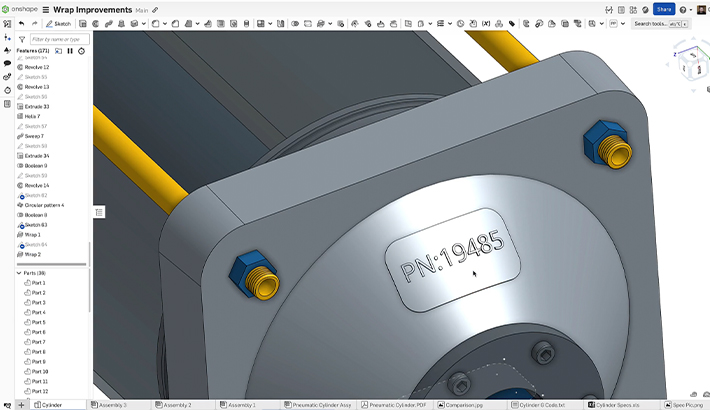In recent years, collaboration between design and manufacturing teams has undergone a radical transformation. Teams that had once worked together under one roof are now often globally distributed and splintered, requiring organizations to shift their approaches to CAD data management to ensure continued success.
Traditional file-based Product Data Management (PDM) software systems – which were introduced to enforce version control and prevent engineers from accidentally overwriting each other’s work – were not created with distributed design teams in mind. They were built for local operations where collaboration between colleagues occurs within the same physical workplace.
Before PDM software arrived on the scene, organizing data was largely done through file folders on local hard drives, administered servers, and manual processes that were not only time-consuming and inefficient but extremely frustrating. When you’ve got thousands of folders scattered across multiple computers, it can be difficult to keep track of which files are the newest, where to find them, and who has access to them.
Manual data management through Windows folders merely became the digitally cluttered version of physically cluttered paper files in overstuffed file cabinets.

Can you organize these files, please? (unpslash.com / @krystagrusseck)
The Rise of File-Based PDM Software
So to address the aggravating problem of version control, file-based PDM software emerged as a more effective solution than manually organizing desktop data.
Here are a few common data management problems that the first generation of PDM – an external system layered on top of CAD software – handled much better than the old ad-hoc approach of sorting desktop folders:
1. Unorganized Data: A key challenge with managing a local hard drive is that it can become easily cluttered and difficult to find the data you need at the moment you need it. This inevitably leads to a lot of wasted time.
2. Inefficient Collaboration: Local hard drive folder management is not suitable for efficient collaboration with colleagues. If one team member makes edits to a file, other team members have no visibility of the latest changes.
3. Limited Accessibility: Unlike cloud storage, which can be accessed from any device with an internet connection, a local hard drive is limited to the physical machine on which it is stored. This makes it difficult to share and collaborate with other users who may not have access to the same local machine.
4. Security Risks: Local hard drives can put intellectual property at risk. Without the right security measures in place, unauthorized users may have access to your confidential information.
Compared to the manual way, external file-based PDM systems were a quantum leap in progress for organizing CAD files. By having all the product information stored in one centralized database – and by enforcing version control with rigid protocols – engineers and extended design teams could minimize mistakes, avoid accidentally overwriting each other’s work, and improve collaboration between departments.
However, file-based PDM systems came with significant drawbacks as well, specifically when multiple team members needed to work on the same design file concurrently. The check-in/check-out protocols of file-based PDM enforce a serial workflow. If an engineer is working on a file, he or she needs to first check it out of the vault. None of their colleagues can work on it until it is checked back in the vault.

Did PDM Technology Become Outdated?
Investing in technology is always a balancing act. How long will a new technology stick around before it has to be replaced by something newer, quicker, and more efficient? The majority of companies today still use outdated file-based PDM systems, which can be a jarring experience for newly hired engineers or teams that value agility.
The need for a new generation of PDM became apparent when existing systems were no longer capable of keeping up with the changing needs of modern product development.
For example, traditional file-based CAD systems assume that a single user is responsible for updating a single master design file. Because collaboration was not prioritized during the early development of PDM, many obstacles persist for teams that need to work more closely together.
For file-based CAD users to collaborate on a single design file, an engineer would need to make a duplicate of the design file and send it out to coworkers, typically by email or a file-sharing service like Google Drive or Dropbox. Once the coworker receives their copy, they need to figure out the best method to communicate any changes or recommendations back to the original author.
So any attempt to collaborate outside the PDM system’s check-in/check-out protocols invites the same kind of version control issues that PDM was created to prevent.
It's easy to see how suggestions for design improvements or other critical feedback could get lost throughout the process of examining, aggregating, and reviewing comments back and forth between multiple stakeholders using multiple channels of communication.
File-based PDM also has a visibility problem.

Keeping information in a vault complicates teamwork. (unsplash.com / @jdent)
All users can see is the latest data that is in the vault. There’s absolutely no way to know if someone else has a copy outside of it. Maybe they’ve followed the procedure with the PDM system and put a lock on the file. Or maybe they haven’t. Is the PDM system up to date? Nobody knows because the PDM vault doesn’t update in real time. It only updates when people go through the trouble of updating it.
Who Wants Painfully Delayed Manufacturing?
As for teams that generally stick to the strict check-in/check-out protocols of file-based PDM, the quest for version control comes at a steep price.
Remember, when one person checks out a design file, no one else can work on it until the file is checked back into the vault.
If you are waiting for access, the PDM vault will tell you who has “your” file, so you can track him or her down and check its status. Sometimes the offending co-worker is already done with the file but forgot to return it. People get busy and distractions happen. Although file-based PDM systems were designed with the best of intentions, they create a whole new set of problems. By locking co-workers out, the system inherently forces you to work serially instead of collaborating together.
Seems like a terrible and unnecessary trade-off, doesn’t it? In this case, the old-generation PDM may as well stand for “Painfully Delayed Manufacturing.”
Serializing work is incredibly inefficient. Imagine a book club that has to share one copy of the same book. In such a book club, only one member could read the story at a time – instead of everyone enjoying it concurrently. This book conversation would take a year to get started!

Imagine a book club that has to share one copy of the same book. (unsplash.com / @rumandraisin)
The problem has never been with the idea behind PDM. The problem is that PDM technology hasn't changed fast enough to keep up with industry needs. The market demanded a new generation of PDM technology, rethinking the woefully outdated approach to version control.
Cloud-Native PDM Delivers Proper Design Momentum
Onshape is often described as cloud-native CAD with built-in PDM, but you might also think of it as a cloud-native PDM system with built-in CAD. The platform was created from scratch with data management at its core versus including it as an afterthought.
Here are five benefits of Onshape’s cloud-native PDM:
1. Lower Cost
Onshape’s built-in PDM is a cost-effective solution that eliminates the need for expensive add-on PDM, IT administration, and integration. As a browser-based solution, companies don’t need to invest in pricey annual hardware/software upgrades, or dedicate time and resources to maintaining the system – it’s all taken care of for you.
2. Automated Version Control
Onshape’s data-driven model allows users to easily track changes and keep a historical record of all updates made to the design. You can see who made what modifications and when. Made a mistake? Onshape allows you to instantly revert back to any prior stage of the design, with unlimited "undo."
3. Secure Data Sharing
Onshape’s PDM is seamlessly built into the workflow of part and assembly design. Onshape provides stronger IP security than a file-based PDM vault. All data is securely stored in the cloud following industry-leading security practices and certifications.
4. Easy Collaboration
With Onshape, entire teams may edit the same design document synchronously or asynchronously, eliminating bottlenecks. Onshape’s agile methodology promotes open communication and helps democratize the work environment. Teams can quickly create annotations, callouts, and notes directly onto the model. You can swiftly share your ideas and views with others without the delays of sending emails or text messages back and forth.
5. Comprehensive Search
Onshape’s PDM solution provides an intuitive search interface that makes it easy to find the files you need. This helps to make the product development process more efficient and ensures that everyone is working with the most up-to-date information.
Never Choose Between Accuracy & Speed Again
Onshape users never have to choose between version control and an agile workflow. Those concepts are finally not contradictory. On the contrary, cloud-native PDM accelerates the product development cycle, eliminating the traditional hassles and stress of data management so you can focus on creating better designs.
If your design process has ever been slowed down by agonizing serial PDM workflows, what are you waiting for? Cloud-native PDM is waiting for you!
Start Your Next
Project in Onshape
Find the cloud CAD plan that's
right for you and your business.









